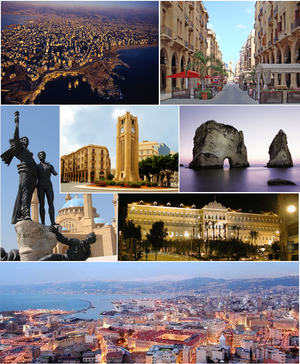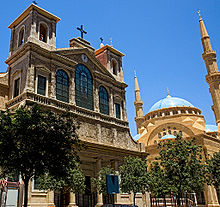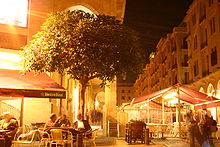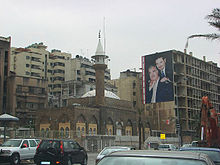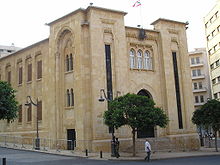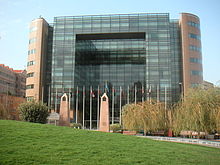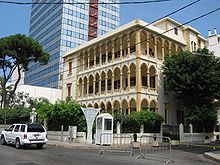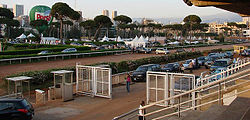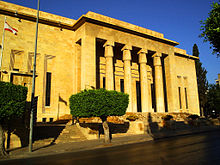- Beirut
-
This article is about the Lebanese city. For other uses, see Beirut (disambiguation).
Coordinates: 33°53′13″N 35°30′47″E / 33.88694°N 35.51306°E
Beirut
بيروت Bayrūt
Beyrouth (French)
Flag
SealLocation in Lebanon. The surrounding district can be seen on the map. Coordinates: 33°53′13″N 35°30′47″E / 33.88694°N 35.51306°E Country Lebanon Governorate Beirut, Capital City Government – Mayor Bilal Hamad Area – City 20 km2 (7.7 sq mi) – Urban 100 km2 (38.6 sq mi) – Metro 200 km2 (77.2 sq mi) Population – City 750,000 – Urban 1,900,000 – Metro 2,250,000 ~ 3,000,000 Time zone +2 – Summer (DST) +3 (UTC) Website City of Beirut Beirut (Arabic: بيروت Bayrūt, Greek: Βηρυττός, French: Beyrouth) is the capital and largest city of Lebanon, with a population ranging from 1 million to more than 2 million (as of 2007). Located on a peninsula at the midpoint of Lebanon's Mediterranean coastline, it serves as the country's largest and main seaport, and also forms the Beirut Metropolitan area, which consists of the city and its suburbs. The first mention of this metropolis is found in the ancient Egyptian Tell el Amarna letters, dating to the 15th century BC. The city has been continuously inhabited since.
Beirut holds Lebanon's seat of government, and plays a central role in the Lebanese economy with its city centre, Hamra, Verdun, and Ashrafieh-based corporate firms and banks. The city is the focal point of the region's cultural life, renowned for its press, theatres, cultural activities and nightlife. After the destructive Lebanese civil war, Beirut underwent major reconstruction,[1][2][3] and the redesigned historic city centre, marina, pubs and nightlife districts have once again rendered it a tourist attraction. Beirut was named the top place to visit in 2009 by The New York Times.[4] It was also listed as one of the ten liveliest cities in the world by Lonely Planet in 2009.[5]
In 2011, MasterCard Index revealed that Beirut had the second highest visitor spending levels in the Middle East and Africa. Dubai came in first with $7.8 billion, followed by Beirut with $6.5 billion, Tel Aviv with $3.8 billion, Cairo at $3.7 billion and Johannesburg with $3.3 billion. At the same time it was listed as the ninth most-visited, and as such it is still considered a "high-end" destination.
Contents
Archaeology and Prehistory
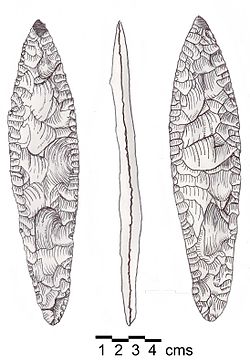 Canaanean Blade. Suggested to be part of a javelin. Fresh grey flint, both sides showing pressure flaking. Somewhat narrower at the base suggesting a haft. Polished at the extreme point. Found on land of the Lebanese Evangelical School for Girls in the Patriarchate area of Beirut, Lebanon.
Canaanean Blade. Suggested to be part of a javelin. Fresh grey flint, both sides showing pressure flaking. Somewhat narrower at the base suggesting a haft. Polished at the extreme point. Found on land of the Lebanese Evangelical School for Girls in the Patriarchate area of Beirut, Lebanon.
Several prehistoric archaeological sites were discovered within the urban area of Beirut, revealing flint tools of sequential periods dating from the Middle Paleolithic and Upper Paleolithic, through the Neolithic to the Bronze Age.
Beirut I or Minet el Hosn was listed as "Beyrouth ville" by L. Burkhalter and said to be on the beach near the Orent and Bassoul Hotels in central Beirut on the Avenue de Français.[6][7] The site was discovered by Lortet in 1894 and discussed by Jesuit Father Godefroy Zumoffen in 1900.[8] The flint industry from the site was described as Mousterian and is held by the Museum of Fine Arts of Lyon.[9]
Beirut II or Um el Khatib was suggested by L. Burkhalter to have been north of Tarik el Jedideh, where P.E. Gigues discovered an Énéolithique (Chalcolithic) flint industry at around one hundred meters above sea level. The site was built on and destroyed by 1948.[9]
Beirut III, Furn esh Shebbak or Plateau Tabet was suggested to have been located on the left bank of the Nahr Beirut river. L. Burkhalter suggested that it was west of the Damascus road although this determination has faced criticism by Lorraine Copeland.[9] P. E. Gigues discovered a series of Neolithic flint tools on the surface along with the remains of a structure suggested to be a hut circle. Auguste Bergy also discussed polished axes that were found at this site which has now completely disappeared due to construction and urbanization of the area.[10]
Beirut IV or Furn esh Shebbak, river banks was also on the left bank of the river and on either side of the road leading eastwards from the Furn esh Shebbak Police Station towards the river that marked the city limits. The area was covered in red sand that represented Quaternary river terraces. The site was found by Jesuit Father Dillenseger and published by fellow Jesuits; Godefroy Zumoffen,[8] Raoul Describes[11] and Auguste Bergy.[10] Collections from the site were made by Bergy, Describes and another member of the Society of Jesus, Paul Bovier-Lapierre. A large number of Middle Paleolithic flint tools were found on the surface and side gullies that drain into the river. These included around 50 varied bifaces accredited to the Acheulean period, some with a lustrous sheen, now held at the Museum of Lebanese Prehistory. Henri Fleisch also found an Emireh point amongst material from the site, which has now disappeared beneath buildings.
Beirut V or Nahr Beirut was discovered by Father Dillenseger and said to be in an orchard of Mulberry trees on the left bank of the river, near the mouth and said to be close to the railway station and bridge to Tripoli. Levallois flints and bones were found amongst brecciated deposits along with similar surface material.[12] The area has now been built on.[13]
Beirut VI or Patriarchate was a site discovered during building operations, somewhere on the property of the Lebanese Evangelical School for Girls in Beirut's Patriarchate area. It was notable for the discovery of a finely styled Canaanean blade javelin suggested to date to the Néolithique Ancien or Néolithique Moyen periods of Byblos and held in the school library.[9]
Beirut VII or Rivoli Cinema and Byblos Cinema sites near the Bourj in the Rue el Arz area are two sites discovered by Lorraine Copeland and Peter Wescombe in 1964 and examined by Diana Kirkbride and Roger Saidah. One site was behind the parking lot of the "Byblos" Cinema and showed collapsed walls, pits, floors, charcoal, pottery and flints. The other overlooking a cliff west of the "Rivoli" Cinema was composed of three layers resting on limestone bedrock. Fragments of blades and broad flakes were recovered from the first layer of black soil, above which some Bronze Age pottery was recovered in a layer of grey soil. Pieces of Roman pottery and mosaics were found in the upper layer.[9] Middle Bronze Age tombs were found in this area and the ancient tell of Beirut is thought to be in the Borj area.[14]
History
Beirut's history goes back more than 5000 years.[15] According to the Encyclopædia Britannica, the antiquity of Beirut is indicated by its name, derived from the Canaanite name of Be'erot (wells), referring to the underground water table that is still tapped by the local inhabitants for general use.[16][17] Excavations in the downtown area have unearthed layers of Phoenician, Hellenistic, Roman, Byzantine, Arab, Crusader and Ottoman remains.[18] The first historical reference to Beirut dates from the 14th century BC, when it is mentioned in the cuneiform[17] tablets of the "Amarna letters". Ammunira of Biruta[19] (Beirut) sent three letters to the pharaoh of Egypt.[20] Biruta is also referenced in the letters from Rib-Hadda of Byblos. The oldest settlement was on an island in the river that progressively silted up. The city was known in antiquity as Berytus. This name was taken in 1934 for the archaeological journal published by the Faculty of Arts and Sciences at the American University of Beirut.[21]
Hellenistic/Roman period
In 140 BC the city was destroyed by Diodotus Tryphon in his contest with Antiochus VII Sidetes for the throne of the Seleucid monarchy. Beirut was soon rebuilt on a more regularized Hellenistic plan, renamed Laodicea in Phoenicia (Greek: Λαοδικεια ή του Φοινίκη) or Laodicea in Canaan, in honor of a Seleucid Laodice. The modern city overlies the ancient one and little archaeology had been accomplished until after the end of the civil war in 1991; now large sites in the devastated city center have been opened to archaeological exploration. A dig in 1994 established that one of Beirut's modern streets, Souk Tawile, still follows the lines of an ancient Hellenistic and Roman one.
Mid-first century coins of Berytus bear the head of Tyche, goddess of fortune; on the reverse, the city's symbol appears: a dolphin entwines an anchor. This symbol was taken up by the early printer Aldus Manutius in 15th century Venice. Beirut was conquered by Agrippa in 64 BC and the city was renamed in honor of the emperor's daughter, Julia; its full name became Colonia Julia Augusta Felix Berytus.[22][23][24] The veterans of two Roman legions were established in the city: the fifth Macedonian and the third Gallic. The city quickly became Romanized. Large public buildings and monuments were erected and Berytus enjoyed full status as a part of the empire.[22]
Under the Romans, it was enriched by the dynasty of Herod the Great, and was made a colonia, Colonia Iulia Augusta Felix Berytus, in 14 BC. Beirut's school of law was widely known at the time.[25] Two of Rome's most famous jurists, Papinian and Ulpian, both natives of Phoenicia, taught at the law school under the Severan emperors. When Justinian assembled his Pandects in the 6th century, a large part of the corpus of laws was derived from these two jurists, and Justinian recognized the school as one of the three official law schools of the empire (533). Within a few years, as the result of a disastrous earthquake (551),[17][22][26] the students were transferred to Sidon.[27] About 30,000 were killed in Berytus alone and, along the Phoenician coast, total casualties were close to 250,000.[23] Beirut was considered the most Roman city in the eastern provinces of the Roman Empire.[28]
 View of Beirut with snow-capped Mount Sannine in the background – 19th century
View of Beirut with snow-capped Mount Sannine in the background – 19th century
Middle Ages
Beirut passed to Arabs in 635.[23][29] It was ruled by the Arslan family (Arab origin from Yemen, relatives through marriage, descendants of the Lakhmids[citation needed]) for 477 years (635–1110)[citation needed]. "Prince Arslan bin al-Mundhir" founded the Principality of Sin-el-Fil in 759 AD in Beirut. This Principality was the base of the afterwards "Principality of Mount Lebanon" which was the base of the establishment of "Greater Lebanon" (Lebanon today).[citation needed] As a trading centre of the eastern Mediterranean, Beirut was overshadowed by Akka during the Middle Ages. From 1110 to 1291 it was in the hands of the Crusaders Kingdom of Jerusalem. John of Ibelin, the Old Lord of Beirut (1179–1236) rebuilt the city after the battles with Saladin, and also built the Ibelin family palace in Beirut.[29]
Ottoman rule
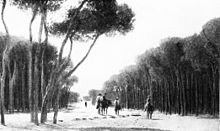 Pine Forest of Beirut, 1914
Pine Forest of Beirut, 1914
Beirut was controlled by local Druze emirs throughout the Ottoman period.[30] One of these, Fakr ed-Din Maan II, fortified it early in the 17th century,[31] but the Ottomans retook it in 1763.[31] With the help of Damascus, Beirut successfully broke Akka's monopoly on Syrian maritime trade and for a few years supplanted it as the main trading centre in the region. During the succeeding epoch of rebellion against Ottoman hegemony at Akka under Jezzar and Abdullah pashas, Beirut declined to a small town (population about 10,000), and was an object of contention between the Ottomans, the local Druze, and the Mamluks. After Ibrahim Pasha captured Akka in 1832,[32] Beirut began its revival.
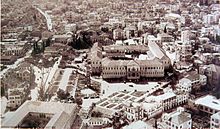 View of Beirut's Grand Serail- circa 1930
View of Beirut's Grand Serail- circa 1930
By the second half of the nineteenth century, Beirut was in the process of developing close commercial and political ties with European imperial powers, France in particular. European interests in Lebanese silk and other export products transformed the city into a major port and commercial centre. Meanwhile, Ottoman power in the region continued to decline. Sectarian and religious conflicts, power vacuums, and changes in the political dynamics of the region culminated in the 1860 Lebanon conflict. Beirut became a destination for Maronite Christian refugees fleeing from the worst areas of the fighting on Mount Lebanon and in Damascus.[33] This in turn altered the ethnic composition of Beirut itself, sowing the seeds of future ethnic and religious troubles there and in greater Lebanon. However, Beirut was able to prosper in the meantime. This was again a product of European intervention, and also a general realization amongst the city's residents that commerce, trade, and prosperity depended on domestic stability.[34]
In 1888, Beirut was made capital of a vilayet in Syria,[35] including the sanjaks Latakia, Tripoli, Beirut, Akka and Bekaa.[36] By this time, Beirut had grown into a very cosmopolitan city, and had close links with Europe and the United States. Beirut also became a centre of missionary activity that spawned impressive educational institutions, such as the American University of Beirut. Provided with water from a British company and gas from a French one, silk exports to Europe came to dominate the local economy. After French engineers established a modern harbor (1894) and a rail link across Lebanon to Damascus, and then to Aleppo (1907), much of the trade was carried by French ships to Marseille. French influence in the area soon exceeded that of any other European power. In 1911, the population mix was reported in the Encyclopædia Britannica as Muslims, 36,000; Christians, 77,000; Jews, 2500; Druze, 400; foreigners, 4100.
An aerial panoramic view of Beirut sometime in the last third of the 19th century
Modern era
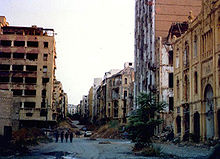 The Green Line that separated west and east Beirut, 1982
The Green Line that separated west and east Beirut, 1982
After the collapse of the Ottoman Empire following World War I, Beirut, along with the rest of Lebanon, was placed under the French Mandate. After Lebanon achieved independence in 1943, Beirut became its capital city. The city remained a regional intellectual capital, becoming a major tourist destination and a banking haven, especially for the Persian Gulf Oil Boom. This era of relative prosperity ended in 1975 when the Lebanese Civil War broke out throughout the country.[37][38] During most of the war, Beirut was divided between a Muslim west part and the Christian east.[39] The downtown area, previously the home of much of the city's commercial and cultural activities, became a no man's land known as the "Green Line." Many inhabitants fled to other countries. About 60,000 people died in the first two years of the war (1975–1976), and much of the city was devastated. One particularly destructive period was the 1978 Syrian siege against Achrafiyeh, the main Christian district of Beirut. Syrian troops relentlessly bombed the eastern quarter of the city; however, Christian militias managed to counter and defeat multiple attempts by Syria's elite forces to capture the strategic area in a three-month campaign later known as the "100 days war". Another destructive chapter was the 1982 Israeli invasion, during which most of West Beirut was under siege by Israeli troops. In 1983, French and US barracks were bombed by Hezbollah, killing 241 American servicemen, 58 French servicemen, 6 civilians and the 2 suicide bombers.[40][41][42]
Since the end of the war in 1990, the people of Lebanon have been rebuilding Beirut, and by the start of the 2006 Israel-Lebanon conflict the city had somewhat regained its status as a tourist, cultural, and intellectual center in the Middle East, as well as a centre for commerce, fashion, and media. The reconstruction of downtown Beirut has been largely driven by Solidere, a development company established in 1994 by Rafik Hariri. Beirut is home to the international designer Elie Saab, jeweller Robert Moawad, and to some popular satellite television stations, such as Future TV, New TV and others. The city was host to the Asian Club Basketball Championship and the Asian Football Cup. Beirut also successfully hosted the Miss Europe pageant eight times, 1960–1964, 1999, 2001–2002.
The 2005 assassination of former Lebanese Prime Minister Rafik Hariri near the Saint George Bay in Beirut shook the entire country.[43][44] Approximately one million people gathered for an opposition rally in Beirut a month after the death of Hariri.[45][46] The Cedar Revolution was the largest rally in Lebanon's history at that time.[47] The last Syrian troops withdrew from Beirut on 26 April 2005.[48] The two countries established diplomatic relations on 15 October 2008.[49] During the 2006 Lebanon War, however, Israeli bombardments seeking Hezbollah targets resulted in damage in many parts of Beirut, especially the poorer and largely Shiite South Beirut, which is controlled by Hezbollah. In May 2008, violent clashes broke out in Beirut, after the government decided to disband Hezbollah's network of communications (which it later rescinded) between the government allies that were relocated in the capital and the forces of the opposition briefly before handing it over to the control of the Lebanese Army.
In the aftermath of these events, all clashing parties travelled to the Qatari capital, Doha to attend a national dialogue conference after an invitation from the prince of the country. On the conclusion of the meeting, many decisions had been reached, including the appointment of a new president of the country and the establishment of a new national government with all the political adversaries involved. As a result, the opposition's camp in the capital was removed, as underlined in the Doha Agreement.
Geography
 Pigeons' Rock (Raouché)
Pigeons' Rock (Raouché)
Beirut is positioned on a peninsula extending westward into the Mediterranean Sea,[50] about 94 km (58 mi) north of the Lebanon-Israel border.[51] The city is flanked by the Lebanon mountains; it has taken on a triangular shape, largely influenced by its situation between and atop two hills: Al-Ashrafieh and Al-Musaytibah. The Beirut Governorate area is of 18 square kilometres (6.9 sq mi), and the city's metropolitan area is of 67 square kilometres (26 sq mi).[50] Beirut's coast is rather diverse; rocky beaches, sandy shores and cliffs are situated beside one another.
Climate
Beirut has a Mediterranean climate characterized by a hot, dry summer, a pleasant autumn and spring, and a cool, rainy winter. August is the hottest month, with a monthly average high temperature of 32 °C (84 °F), and January and February are the coldest months with a monthly average low temperature of 10 °C (50 °F). During the afternoon and evening, the prevailing wind direction is from the west, i.e., onshore, or inland from the Mediterranean Sea; at night the wind direction reverses to offshore, i.e., blowing from the land out to the sea.
The average annual rainfall is 890 millimetres (35.1 inches), virtually all of which falls in winter, autumn and spring. Much of the rain in autumn and spring falls on a limited number of days in heavy downpours. In winter, however, the rain is more evenly spread over a large number of days. Summer receives very little (if any) rainfall. Snow in Beirut is rare and usually occurs without accumulation. However, hail and sleet can occur quite frequently in winter. Exceptions are three big snowstorms that occurred in 1920, 1942 and 1950.
Climate data for Beirut Month Jan Feb Mar Apr May Jun Jul Aug Sep Oct Nov Dec Year Record high °C (°F) 25
(77)31
(88)36
(97)37
(99)42
(108)40
(104)37
(99)37
(99)37
(99)38
(100)33
(91)29
(84)42
(108)Average high °C (°F) 17
(63)17
(63)19
(66)22
(72)26
(79)28
(82)31
(88)32
(90)30
(86)27
(81)23
(73)18
(64)24.2
(75.5)Average low °C (°F) 11
(52)11
(52)12
(54)14
(57)18
(64)21
(70)23
(73)23
(73)23
(73)21
(70)16
(61)13
(55)17.2
(62.9)Record low °C (°F) −1
(30)−1
(30)2
(36)6
(43)10
(50)13
(55)18
(64)17
(63)16
(61)11
(52)5
(41)−1
(30)−1
(30)Precipitation mm (inches) 191
(7.52)158
(6.22)94
(3.7)56
(2.2)18
(0.71)3
(0.12)0
(0)0
(0)5
(0.2)51
(2.01)132
(5.2)185
(7.28)893
(35.16)Avg. rainy days (≥ 0.25 mm) 15 12 9 5 2 0 0 0 1 4 8 12 68 Sunshine hours 155 140 186 240 310 360 372 341 270 248 210 155 2,987 Source: BBC News [52] Quarters and sectors
Beirut is divided into 12 municipality recognized quarters (quartiers):[53]
- Achrafieh
- Dar El Mreisse
- Bachoura
- Mazraa
- Medawar
- Minet El Hosn
- Moussaitbeh
- Port Beirut
- Ras Beirut
- Rmeil
- Saifi Village
- Zoukak El Blatt
These quarters are divided into sectors (secteurs).[54]
Three of the 12 official Palestinian refugee camps in Lebanon are located in Beirut: Burj el-Barajneh, Shatila and Mar Elias refugee camp, all located in the south of the city.[55] Of the fifteen unregistered or unofficial refugee camps, Sabra, which lies adjacent to Shatila, is also located in Beirut.[56]
Demographics
There are wide-ranging estimates of Beirut's population, from as low as 938,940 people,[57] to 1,303,129 people,[58] to as high as 2,012,000.[59] The lack of an exact figure is because no population census has been taken in Lebanon since 1932.[60]
Beirut is one of the most religiously diverse cities of Lebanon and all of the Middle East,[61] with a significant presence of both Christians and Muslims. There are nine major religious communities in Beirut (Maronite Catholic, Greek Orthodox, Greek Catholic, Armenian Apostolic, Armenian Catholic, Protestant, Sunni Muslim, Shiite Muslim, Druze). Family matters such as marriage, divorce and inheritance are still handled by the religious authorities representing a person's faith (the "millet" system). Calls for civil marriage are unanimously rejected by the religious authorities but civil marriages held in another country are recognized by Lebanese civil authorities. Until the mid-20th century, Beirut was also home to a Jewish community in the Wadi Abu Jamil neighbourhood in the Bab Idriss sector of Zokak el-Blat (see History of the Jews in Lebanon). According to the 2009 Lebanese general elections, a total of 435,462 people voted in Beirut, of them 192,910 (45%) were Sunni Muslims, 60,202 (14%) were Shia Muslims, 46,744 (11%) were Armenian Orthodox, 42,728 (10%) were Greek Orthodox, 24,800 (6%) were Maronite Catholics, 18,923 (4%) were Greek Catholics, 9,623 (2%) were Armenian Catholics, 6,883 (1%) were Protestant, 5,374 (1%) were Jews, 5,251 (1%) were Druze, 218 were Alawis, and 21,806 were Other Christians.
Before the civil war the neighborhoods of Beirut were fairly heterogeneous, but they have become largely segregated by religion since the conflict. East Beirut is characterized by a largely Christian population, with a small Sunni Muslim minority. Meanwhile, West Beirut is categorized by a Sunni Muslim majority with small minorities of Christians and Druze. Since the end of the civil war, East and West Beirut have begun to see an increase in Sunni Muslims and Christians moving into each half. Beirut's southern suburbs are largely populated by Shi'ite Muslims, while Beirut's Eastern suburbs are largely Christian. Northern Beirut has had a large Lebanese Protestant community since the 19th century.
Economy
The economy of Beirut is diverse, ranging from publishing, banking, trade to a diverse industry. From the 1950s to the start of the conflict in 1975, Beirut was the region's financial services center. At the onset of the oil boom starting in the 1960s, Lebanon-based banks were the main recipients of the region's petrodollars.[62] Middle East Airlines has its head office in Beirut.[63] In addition, the Banque du Liban, the central bank of Lebanon, is headquartered in Beirut.[64]
Government
The capital Beirut is the seat of the Lebanese Parliament[65] and of the government,[66] and encompasses all the Ministries, most of the public administrations, embassies and consulates.[67] Beirut is one of six mohafazat (state governorates; mohafazah, singular), with the others being Beqaa, North Lebanon, South Lebanon, Mount Lebanon and Nabatiye.[68]
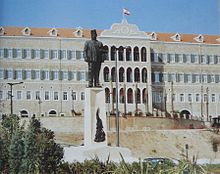 The Grand Serail
The Grand Serail
Governors of Beirut[69] Name Took office Left office 1 Kamel Abbas Hamieh 1936 1941 2 Nicolas Rizk 1946 1952 3 George Assi 1952 1956 4 Bachour Haddad 1956 1958 5 Philip Boulos 1959 1960 6 Emile Yanni 1960 1967 7 Chafik Abou Haydar 1967 1977 8 Mitri El Nammar 1977 1987 9 George Smaha 1987 1991 10 Nayef Al Maaloof 1992 1995 11 Nicolas Saba 1995 1999 12 Yaacoub Sarraf 1999 2005 13 Nassif Kaloosh 2005 International organizations
The city is home to numerous international organizations. The United Nations Economic and Social Commission for Western Asia (ESCWA) is headquartered in Downtown Beirut[70][71] while the International Labour Organization (ILO)[72] and UNESCO (United Nations Educational, Scientific and Cultural Organization)[73] both have regional offices in Beirut covering the Arab world. The Arab Air Carriers Organization (AACO),[74] the Union of Arab Banks[75] and the Union of Arab Stock Exchanges[76] are also headquartered in Beirut.
Education
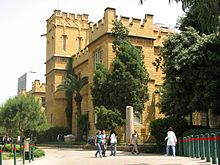 The museum of the American University of Beirut
The museum of the American University of Beirut
Higher education in Beirut, and all over Lebanon, is provided by technical and vocational institutes, university colleges, university institutes and universities. Among these numbers of institutions nationwide, the Lebanese University is the only public institution in the capital.[77] The responsibility of the Directorate General of Higher Education is responsible for managing the university colleges, university Institutes and Universities in Beirut and nationwide.[77]
Among the private schools in Beirut are the American Community School, the Collège Notre-Dame de Jamhour, International College, Beirut, the Carmel Saint-Joseph, the Collège Louise Wegmann, Rawdah High School, the Saint Mary's Orthodox College,[78] the Collège Protestant Français, the Lycée Franco-Libanais Verdun, the Collège du Sacré-Coeur Gemmayzé, the Grand Lycée Franco-Libanais, the Collège Notre Dame de Nazareth, the Armenian Evangelical Central High School and the German School of Beirut.
The higher education system is based on the Lebanese Baccalaureate but the French Baccalaureate is accepted as an equivalent. Before being admitted to any higher education institution, one must achieve his or her Baccalaureate examinations. Baccalaureate technique is an alternative to credentials.[77]
Foreign students who wish to study in higher Lebanese institutions must also meet Lebanese qualifications. Their examinations must be equivalent to the Baccalaureate system before they are granted admission to higher institutions. They are not subject to any special quota system, and scholarships are granted within the framework of bilateral agreements concluded with other countries.[77] Degrees obtained outside Lebanon must be certified by the Lebanese embassy abroad and the Ministry of Foreign Affairs in Lebanon. Then, candidates must go in person to the Secretariat of the Equivalence Committee with required documents.[79]
The American University of Beirut is the oldest university in the country and the region. In 1862 American missionaries in Lebanon and Syria, under the American Board of Commissioners for Foreign Missions, asked Dr. Daniel Bliss to establish a college of higher learning that would include medical training. On April 24, 1863, while Dr. Daniel Bliss was raising money for the new college in the United States and England, the State of New York granted a charter for the Syrian Protestant College. The college, which was renamed the American University of Beirut in 1920, opened with a class of 16 students on December 3, 1866. Dr. Bliss served as its first president, from 1866 until 1902. The American University of Beirut (AUB) has been accredited as an institution since 2004 by the Commission on Higher Education of the Middle States Association of Colleges and Schools (3624 Market Street, Philadelphia, PA 19104, Tel. 267-284-5000). AUB’s accreditation was most recently reaffirmed in June 2009, after the completion of an extensive self-study that was reviewed by educational experts chosen in consultation with Middle States. The University’s next full accreditation cycle is due in 2018–19. Over the last several years, a number of University programs and faculties have also sought accreditation with more specialized bodies. The Faculty of Health Sciences’ Graduate Public Health program became the first such program to be accredited by the Council on Education for Public Health (CEPH) outside of North America. Similarly, the Rafic Hariri School of Nursing became the first nursing school beyond American territories to have BSN and MSN programs accredited by the Commission on Collegiate Nursing Education (CCNE). In April 2009, undergraduate and graduate programs at the Suliman S. Olayan School of Business were accredited by the Association to Advance Collegiate Schools of Business (AACSB). Most recently, in July 2010, four undergraduate Engineering programs at AUB’s Faculty of Engineering and Architecture were accredited by ABET Inc. (Accreditation Board for Engineering and Technology). In general, the accreditation process is intended to strengthen and sustain the quality and integrity of a university, faculty, or program, confirming that it is worthy of public confidence. AUB has been registered with and recognized by the New York State Education Department (NYSED) since 1863. Its degrees are recognized by the Lebanese government through the equivalence committees of the Ministry of Education and Higher Education.
Beirut is also home to the Lebanese American University (LAU), which is Chartered by the Board of Regents of the University of the State of New York. LAU is fully accredited by the New England Association of Schools and Colleges.[80][81][82] LAU also offers the only Pharm.D program outside the United States of America that is fully accredited by the American Accreditation Council for Pharmacy Education, as well as an architecture degree equivalent to the French DEA allowing graduates to practice in the European Union. All engineering programs at LAU are accredited by the American accreditation agency ABET. The Computer Science program at LAU is the first and only ABET accredited program in Lebanon.[83][84] Other universities in Beirut include the University of Balamand (Faculty of Health Sciences), Université Saint-Joseph, and École Supérieure des Affaires (business school).
Transportation
The city's renovated airport is the Rafic Hariri International Airport and is located in the southern suburbs. By land, it is served by either service taxi or taxicab. Service taxis are cheaper than normal taxis, but to avoid misunderstandings, an agreement over pricing needs to be made before setting off.[85]
Beirut has frequent bus connections to other cities in Lebanon and major cities in Syria. The Lebanese Commuting Company, or LCC in short, is just one of a handful brands of public transportation all over Lebanon.[86] On the other hand, the publicly owned buses are managed by Office des Chemins de Fer et des Transports en Commun (OCFTC), or the "Railway and Public Transportation Authority" in English. Buses for northern destinations and Syria leave from Charles Helou Station.[87]
Apart from the international airport, the Port of Beirut is another port of entry. As a final destination, Lebanon can be reached by ferry from Cyprus or by road from Damascus.[85]
Culture
The culture of Beirut has evolved under the influence of many different peoples and civilizations, such as Greeks, Romans, Arabs, Ottoman Turks and French, among others. The law school in downtown Beirut was one of the world's earliest and was considered to be a leading center of legal studies in the Eastern Roman Empire. All in all, the ruins of downtown Beirut have been found to contain seven layers of civilization. This history of cosmopolitanism is a point of pride for many Lebanese.[88]
Beirut hosted the Francophonie and the Arab League summits in 2002. In 2007, Beirut hosted the ceremony for Le Prix Albert Londres,[89][90] which rewards outstanding francophone journalists every year. The city also hosted the Jeux de la Francophonie in 2009.[91][92] In 2009, Beirut was proclaimed World Capital of the Book by UNESCO.[93]
Beirut has also been called the "party capital of the Arab world".[94] Rue Monnot has an international reputation among clubbers.[95] Additionally Rue Gouraud in districts such as Gemmayze and Mar Mikhael have emerged as new hotspots for bar patrons and clubbers.
Museums
The National Museum of Beirut is the principal museum of archaeology in Lebanon. About 1,300 artifacts are exhibited, ranging in date from prehistoric times to the medieval Mamluk period.[96] The American University of Beirut (AUB) archaeological museum is the third oldest museum in the Middle East, exhibiting a wide range of artifacts from Lebanon and neighboring countries.[97] Sursock Museum was built by the Sursock family at the end of the 19th century as a private villa. It was then donated to the Lebanese state and now houses Beirut's most influential and popular art museum. The permanent collection shows a collection of Japanese engravings and numerous works of Islamic art, and temporary exhibitions are shown throughout the year. Robert Mouawad Private Museum exhibits Henri Pharaon's private archaeology and antiques collection, located near Beirut's the Grand Serail.[98] Planet Discovery is a children’s science museum with interactive experiments, exhibitions, performances and workshops and awareness competitions.[99] The Saint Joseph University opened the Museum of Lebanese Prehistory in 2000, the first prehistory museum in the Arabic Middle East displaying bones, stone tools and neolithic pottery collected by Jesuits.[100]
Media
Beirut is the main center in Lebanon for the television, newspaper, and book publishing industries. The television stations include Tele Liban, LBC, Future TV, OTV (Orange TV), MTV, New TV, Al-Manar, ANB, and NBN. The newspapers include An-Nahar, As-Safir, Al Mustaqbal, Al Akhbar, Al-Balad, Ad-Diyar, Al Anwar, Al Sharq, L'Orient Le Jour and the Daily Star. Beirut is one of the main media hubs in the Arab world, the others being Cairo and Dubai.
Sports
Beirut, in addition to Sidon and Tripoli, hosted the 2000 AFC Asian Cup.[101][102] There are two stadiums in the city, Camille Chamoun Sports City Stadium and Beirut Municipal Stadium.
Basketball is the most popular sport in Lebanon. Currently four teams playing in the Lebanese Basketball League div. 1 are located in Beirut. Best two teams in Lebanese Basketball history : Sagesse and Sporting Al Riyadi Beirut in addition of Hoops Club and Antranik SC.
Other sports events in Beirut include the annual Beirut Marathon, Hip ball, a weekly horse racing at Beirut Hippodrome, and golf and tennis tournaments that take place at Golf Club of Lebanon.
Recently Beirut has taken to rugby league as well, with three out of the five teams in the Lebanon Championship based in Beirut.
Arts and fashion
There are hundreds of art galleries in Beirut and its suburbs. Lebanese people are very involved in art and art production. More than 5000 fine art artists and equal artists working in music, design, architecture, theatre, film, photography and other forms of art are producing in Lebanon. Every year hundreds of fine art students graduate from universities and institutions. Artist workshops exist all over Lebanon. Recently, the inauguration of the Beirut Art Center in the Jisr El Wati district of Beirut added to the number of exhibition spaces available in Beirut, with an addition of a screening and performance room, mediatheque, bookstore, cafe and terrace. On another scale, fashion and couture are thriving. Fashion houses are opening up and a number of international fashion designers have displayed their work in various fashion shows.[103] Most major fashion labels have shops in Beirut, but the city is also home to a number of local fashion designers, some of whom have reached international fame and success. These include Elie Saab, Zuhair Murad, Jean Faris, Rabih Kayrouz and Abed Mahfouz.[103]
Tourism
Beirut is a destination for tourists from both the Arab world and West.[104] The once destroyed city centre is thriving once again. Its former reputation as a crossroads between three continents and gateway to the East has been restored. Beirut is one of several so called “Paris[es] of the East”,[105] and there is plenty of sightseeing, shopping, cuisine, and nightlife to keep a tourist within the city limits.[106][not in citation given] The city has sleek, modern buildings alongside arabesque Ottoman buildings, giving Beirut a unique and distinctive style often not seen in other Middle Eastern cities.[107]
In Travel + Leisure magazine's World Best Awards 2006, Beirut was ranked 9th best city in the world.[108] However, the list was voted upon before the war broke out in Lebanon that same year. The Guardian claimed Beirut as one of the top ten cities in the world in 2008.[109] The New York Times ranked Beirut as the number one place to go in 2009 on its "44 places to go" list of 2009.[4] Many of the tourists are returning Lebanese expatriates, but many are also from Western countries. Approximately 4.6 million visitors were expected to visit in 2010; the previous record was 1.4 million in 1974.[110]
International relations
See also: List of twin towns and sister cities in LebanonTwin towns – Sister cities
Beirut is twinned with:
 Mexico City, Mexico[111]
Mexico City, Mexico[111] Moscow, Russia[111]
Moscow, Russia[111] Nicosia, Cyprus[citation needed]
Nicosia, Cyprus[citation needed] Quebec City, Canada[111]
Quebec City, Canada[111] Rio de Janeiro, Brazil
Rio de Janeiro, Brazil Split, Croatia[citation needed]
Split, Croatia[citation needed] Strasbourg, France
Strasbourg, France- Template:Country data ksa Jeddah, ksa
 Yerevan, Armenia[111][115]
Yerevan, Armenia[111][115]
See also
References
Bibliography
- Kassir, Samir. Beirut (University of California Press; 2010) a scholarly history
- Linda Jones Hall, Roman Berytus: Beirut in Late Antiquity, 2004.
- Samir Kassir, Histoire de Beyrouth, Fayard 2003.
- Richard Talbert, Barrington Atlas of the Greek and Roman World, (ISBN 0-691-03169-X), p. 69.
- Rabih Alameddine, "Koolaids: The Art of War", Abacus 1998, a novel
Notes
- ^ Reconstruction of Beirut, Macalester College
- ^ Lebanon's Reconstruction: A Work in Progress, VOA News
- ^ Beirut: Between Memory and Desire, Worldview
- ^ a b Wise, Zach; Meek/, Miki (2009-01-11). "The 44 Places to Go in 2009 – Interactive Graphic". The New York Times (Beirut (Lebanon);Washington (DC);Galapagos Islands;Berlin (Germany);Las Vegas (Nev);Hawaii;Vienna (Austria);Doha (Qatar);Dakar (Senegal);Phuket (Thailand);Chicago (Ill);Dallas (Tex);Bhutan;Florida Keys;Rome (Italy);Cuba;Penang (Malaysia);Seychelles Islands;Florianopolis (Brazil);Copenhagen (Denmark);Monument Valley;Great Britain;Cologne (Germany);Reykjavik (Iceland);Red Sea;Egypt;Deauville (France);South Africa;India;Kazakhstan;Buffalo (NY);Madagascar;Tasmania (Australia);Stockholm (Sweden);Alaska;Pennsylvania;Zambia). http://www.nytimes.com/interactive/2009/01/11/travel/20090111_DESTINATIONS.html. Retrieved 2009-05-05.
- ^ "Beirut Travel Information and Travel Guide — Lebanon". Lonely Planet. 2009-03-24. http://www.lonelyplanet.com/lebanon/beirut. Retrieved 2009-05-05.
- ^ Burkhalter, L., Bibliographie préhistorique (à suivre) (List of prehistoric sites, continuation and end), BULLETIN DU MUSEE DE BEYROUTH. Tome VIII, 1946-1948, Beyrouth, in-4° br., 173 page, 9 pages de texte arabe, 21 planches en phototypie, nombreuses gravure
- ^ Burkhalter L., Bibliographie préhistorique (suite et fin) (List of prehistoric sites, continuation and end), BULLETIN DU MUSEE DE BEYROUTH. Tome IX, 1949-1950, Beyrouth, in-4° br., 117 pages et 9 pages de texte arabe, 14 planches hors-texte et 1 carte dépliante.
- ^ a b Godefroy Zumoffen (1900). La Phénicie avant les phéniciens: l'âge de la pierre. Impr. catholique. http://books.google.com/books?id=0noLAQAAIAAJ. Retrieved 7 August 2011.
- ^ a b c d e Lorraine Copeland; P. Wescombe (1965). Inventory of Stone-Age sites in Lebanon, p. 73-75 and see fig. XVII on p. 163 for drawing by Peter. J. Wescombe of the javelin found at Beirut VI. Imprimerie Catholique. http://books.google.com/books?id=6YsRRwAACAAJ. Retrieved 21 July 2011.
- ^ a b Bergy, Auguste., La paléolithique ancien stratifié à Ras Beyrouth, Mélanges de l'Université Saint Joseph, Volume 16, 5-6, 1932.
- ^ Describes, Raoul., Quelques ateliers paléolithiques des environs de Beyrouth, Mélanges de l'Université Saint-Joseph, Volume VII, 1921.
- ^ Karge, P., Rephaim : Die Vorgeschichtliche Kultur Palästinas und Phöniziens, Paderborn (First edition), 1917-1918
- ^ Zumoffen, Godefroy., L'âge de la Pierre en Phénicie, L'Anthropologie, Volume 8, page 272, 1898.
- ^ Lauffray, J., Forums et monuments de Béryte, BULLETIN DU MUSEE DE BEYROUTH. Tome VII, 1944-1945, Beyrouth, in-4° br., 124 pages dont 4 de texte arabe, 29 planches hors-texte.
- ^ Under Beirut's Rubble, Remnants of 5,000 Years of Civilization– NYTimes February 23, 1997
- ^ The new encyclopedia Britannica (1993) volume 14, macropaedia, 15th edition, encyclopedia Britannica Inc.
- ^ a b c Profile of Lebanon: History Lebanese Embassy of the U.S.
- ^ Research Projects – History and Archeology, American University of Beirut (AUB)
- ^ Phoenicia in Encyclopaedia Biblica, Case Western Reserve University
- ^ Phoenicia, Jrank.org
- ^ Berytus Archeological Studies, American University of Beirut (AUB)
- ^ a b c About Beirut and Downtown Beirut, DownTownBeirut.com. Retrieved November 17, 2007.
- ^ a b c Beirut Travel Information[dead link], Lonely Planet
- ^ Czech excavations in Beirut, Martyrs' Square, Institute for Classical Archaeology>
- ^ Beirut, Britannica.com
- ^ History of Phoenicia, fullbooks.com. Retrieved November 17, 2007.
- ^ "Saida (Sidon)". Ikamalebanon.com. http://www.ikamalebanon.com/national_heritage/south_nh/sth_cities_nh/saida.htm. Retrieved 2009-05-05.
- ^ Morgan, James F. The Prodigal Empire: The Fall of the Western Roman Empire, page 87
- ^ a b Beirut, Britannica.com
- ^ Druze History, DHF Druze Heritage Foundation
- ^ a b Beirut, Jrank.org
- ^ Corpus Inscriptionum Arabicarum Palaestinae, by Moshe Sharon
- ^ Fawaz, Leila. "The City and the Mountain", 'International Journal of Middle East Studies' 16 no. 4 (Nov. 1984), 493.
- ^ Fawaz, Leila. "The City and the Mountain", 'International Journal of Middle East Studies' 16 no. 4 (Nov. 1984), 490.
- ^ Modern Beirut, Macalester College
- ^ History of Beirut, Lebanon Links
- ^ An Alternate Alternative History, Foreign Policy
- ^ Dancing in the street, The Independent
- ^ Lebanon (Civil War 1975–1992, Global Security
- ^ Terrorism – Terrorist Attacks Chronology, CDI Terrorism Project
- ^ Frontline: Target America: Terrorist Attacks on Americans, 1979–1988, PBS.org
- ^ Historical Fact: Bombing of marine barracks, October 23, 1983, lebaneseforces.com
- ^ History of Lebanon (The Cedar Revolution), LGIC. Retrieved November 19, 2007.
- ^ Watch – The Cedar Revolution, The Winds of Change. Retrieved November 19, 2007.
- ^ 'Record' protest held in Beirut, BBC News
- ^ From Hopeful To Helpless At a Protest In Lebanon, Washingtonpost.com
- ^ Hariri sister calls for justice, CNN International
- ^ On This Day – 26 April, BBC.co.uk
- ^ "Syria, Lebanon Formally Launch Diplomatic Relations". Voanews.com. http://www.voanews.com/english/2008-10-15-voa44.cfm. Retrieved 2009-05-05.[dead link]
- ^ a b Beirut – The Pearl of the Middle East[dead link]
- ^ "Howstuffworks "Geography of Beirut"". Geography.howstuffworks.com. http://geography.howstuffworks.com/middle-east/geography-of-beirut.htm. Retrieved 2009-05-05.
- ^ http://news.bbc.co.uk/weather/forecast/248?&search=beirut&itemsPerPage=10®ion=world
- ^ "Beirut's Official Webcite". http://www.beirut.gov.lb/www.beirut.gov.lb/MCMSAR/%D8%AD%D8%B6%D8%A7%D8%B1%D8%A9+%D8%A8%D9%8A%D8%B1%D9%88%D8%AA/. Retrieved 2008-04-23.
- ^ "Beirut's Official Website". Beirut.gov.lb. http://www.beirut.gov.lb/www.beirut.gov.lb/MCMSEN/Maps+of+Beirut/. Retrieved 2009-05-05.
- ^ Southern suburbal districts include: Chiyah, Ghobeiry, Haret Hreik, Laylake, Tahouitat al Ghadir, Hay al Sillum and formerly Hadath. Eastern suburbs include: Burj Hammoud, Sin el Fil, Dekouane and Mkalles. Hazmiyah is now recognised as an independent municipality. "Lebanon refugee camp profiles". UNRWA. 31 December 2006. http://www.un.org/unrwa/refugees/lebanon.html. Retrieved 2008-04-18.
- ^ Sherifa Shafie. "Palestinian Refugees in Lebanon" (PDF). Force Migration. http://www.forcedmigration.org/guides/fmo018/fmo018.pdf. Retrieved 2008-04-18.
- ^ "United Nations: "Demographic Yearbook 2003", page 53, 2003" (PDF). http://unstats.un.org/unsd/demographic/products/dyb/DYB2003/Table08.pdf. Retrieved 2010-01-17.
- ^ Lebanese Ministry of Environment: "Lebanon State of the Environment Report", Chapter 1, page 11, 2001.[dead link]
- ^ "Encyclopedia of the Nations". Nationsencyclopedia.com. http://www.nationsencyclopedia.com/Asia-and-Oceania/Lebanon-POPULATION.html. Retrieved 2010-01-17.
- ^ Lebanese Ministry of Environment: "Lebanon State of the Environment Report", Chapter 1, page 9, 2001.[dead link]
- ^ At Beirut Protest, a Reminder of Religious Diversity, The New York Times. Retrieved November 17, 2007.
- ^ "[1].retrieved on 27 November 2010.
- ^ "Contact Us." Middle East Airlines. Retrieved on 19 October 2009.
- ^ "Banque du Liban: Offices in Lebanon". retrieved on 2 september 2010.
- ^ "Beirut from the sky, Parliament Square, Ryad el Solh square". Lebanonpanorama.com. http://www.lebanonpanorama.com/frame_src/english/beirut.html. Retrieved 2009-05-05.
- ^ Monday, Jun. 07, 1926 (1926-06-07). "Great Lebanon — TIME". TIME. http://www.time.com/time/magazine/article/0,9171,722011,00.html. Retrieved 2009-05-05.
- ^ "Links". Web.archive.org. 2007-10-12. Archived from the original on 2007-10-12. http://web.archive.org/web/20071012050110/http://www.presidency.gov.lb/presidency/links/links.htm. Retrieved 2009-07-25.
- ^ Beirut – The Pearl of the Middle East[dead link]
- ^ "Beirut's official website". Beirut.gov.lb. http://www.beirut.gov.lb/www.beirut.gov.lb/MCMSARdir1/%D9%85%D8%AD%D8%A7%D9%81%D8%B8%D8%A9+%D8%A8%D9%8A%D8%B1%D9%88%D8%AA/. Retrieved 2010-01-17.
- ^ ICPD+5 NEWS BULLETIN, United Nations General Assembly. Retrieved November 15, 2007.
- ^ "United Nations Economic and Social Commission for Western Asia". Escwa.org.lb. http://www.escwa.org.lb/. Retrieved 2010-01-17.
- ^ "International Labour Organization (Lebanon)". Ilo.org.lb. http://www.ilo.org.lb/. Retrieved 2010-01-17.
- ^ "UNESCO Beirut". Web.archive.org. Archived from the original on 2007-09-10. http://web.archive.org/web/20070910202147/http://portal.unesco.org/beirut. Retrieved 2010-01-17.
- ^ "Arab Air Carriers Organization". Aaco.org. http://www.aaco.org/contact.asp. Retrieved 2010-01-17.
- ^ "Union of Arab Banks". uabonline.org. http://www.uabonline.org/contact.php. Retrieved 2011-01-29.
- ^ "Union of Arab Stock Exchanges". arabstockexchanges.org. http://www.arabstockexchanges.org/uaseportal/portal/contactus.html?pageParam=contactus&menu=8. Retrieved 2011-02-12.
- ^ a b c d Lebanon – Education system
 RTF (26.5 KiB), Unesco.org
RTF (26.5 KiB), Unesco.org - ^ "Educalys website". Educalys.edu.lb. http://www.educalys.edu.lb. Retrieved 2011-09-05.
- ^ Education FAQs[dead link], informs.gov.lb
- ^ "NCUSAR Study Abroad Opportunity". Ncusar.org. http://www.ncusar.org/programs/lau-sinarc.html. Retrieved 2010-06-14.
- ^ "International Served By Pappas Consulting". Pappas-consulting.com. http://www.pappas-consulting.com/international.html. Retrieved 2010-06-14.
- ^ "Blog Archive » About LAU". Universities of Lebanon. 2010-03-15. http://www.universitiesoflebanon.com/2010/03/15/about-lau/. Retrieved 2010-06-14.
- ^ "International Colleagues, International Accreditation Activities, Canada, PDF, ACPE – Accreditation Council for Pharmacy Education". Acpe-accredit.org. 2004-06-30. http://www.acpe-accredit.org/international/accredit.asp. Retrieved 2010-06-14.
- ^ "About LAU | Charter and Accreditation". LAU. http://www.lau.edu.lb/about/charter_acc/index.php. Retrieved 2010-06-14.
- ^ a b "Transportation & Communication". Ikamalebanon.com. http://www.ikamalebanon.com/info/transportation.htm. Retrieved 2010-01-17.
- ^ "Company profile". Lccworld.com. http://www.lccworld.com/profile.asp. Retrieved 2010-01-17.
- ^ Beirut Transport[dead link]
- ^ Inside Beirut: Culture, tripadvisor
- ^ Albert Londres Prizes, France Diplomatie
- ^ Daily Press Briefing, Embassy of France in the U.S.
- ^ (French) Les Jeux de la Francophonie au Liban Beyrouth 2009, Libanvision
- ^ (French) Les Jeux de la Francophonie, Moldavie.fr
- ^ 2009 World Book Capital, un.org
- ^ Butters, Andrew Lee (2009-03-17). "Drugs in the Middle East". Times/CNN. http://mideast.blogs.time.com/2009/03/17/drugs-in-the-middle-east/. Retrieved 2010-03-02.
- ^ Sergeant, Mike (2008-02-13). "Is party over for Beirut's clubbers?". BBC News. http://news.bbc.co.uk/2/hi/middle_east/7241147.stm. Retrieved 2010-03-02.
- ^ History, National Museum of Beirut
- ^ "AUB Museum". Ddc.aub.edu.lb. http://ddc.aub.edu.lb/projects/museum/. Retrieved 2009-05-05.
- ^ "Welcome to Robert Mouawad Private museum". Rmpm.info. http://www.rmpm.info/. Retrieved 2009-05-05.
- ^ "Beirut City Center Culture — Planet Discovery". Solidere. http://www.solidere.com/history/planet.html. Retrieved 2009-05-05.
- ^ "UMAC Worldwide Database of University Museums & Collections". Publicus.culture.hu-berlin.de. http://publicus.culture.hu-berlin.de/collections/detail.php?dsn=549. Retrieved 2011-09-05.
- ^ China Ready to Face Tough Task in Asian Cup Bidding, People's Daily
- ^ Lebanese Football need to make their mark in Asia[dead link], Maxell
- ^ a b Reuters (2011 [last update]). "Lebanese fashion designers reign supreme despite crisis | Reuters". reuters.com. http://www.reuters.com/article/2010/10/13/us-lebanon-fashion-idUSTRE69C3JP20101013. Retrieved 5 July 2011.
- ^ "Born-again Beirut". Fairfax Media. 2005-01-08. http://www.smh.com.au/articles/2005/01/28/1106850092882.html. Retrieved 2010-03-02.
- ^ "Arts & Culture – Guidebooks from the edge, and from the heart". The Daily Star. 2010-03-25. http://www.dailystar.com.lb/article.asp?edition_id=10&categ_id=4&article_id=113126. Retrieved 2010-06-14.
- ^ Mohammad H. Hadla@ Webserv (2007-12-17). "Downloadable Brochures: Hidden Lebanon Brochure". Web.archive.org. Archived from the original on 2007-12-17. http://web.archive.org/web/20071217124302/http://www.destinationlebanon.gov.lb/eng/Brochures.asp. Retrieved 2009-07-25.
- ^ Mohammad H. Hadla@ Webserv (2008-02-13). "What to See & Do in Beirut". Web.archive.org. Archived from the original on 2008-02-13. http://web.archive.org/web/20080213054127/http://www.destinationlebanon.gov.lb/eng/Beirut/See.asp. Retrieved 2009-07-25.
- ^ Travel and Leisure: Top 10 Cities Overall
- ^ Carrell, Severin (2008-10-15). "Lonely Planet guide rates Glasgow as one of the world's top 10 cities". The Guardian. http://www.guardian.co.uk/travel/2008/oct/15/glasgow-scotland. Retrieved 2011-08-23.
- ^ Lutz, Meris (2009-09-26). "Lebanon tourism is back from a holiday". Los Angeles Times. http://www.latimes.com/news/nationworld/world/la-fg-lebanon-tourism26-2009sep26,0,746311.story. Retrieved 2010-01-17.
- ^ a b c d e f g h i j k l "Twinning the Cities". City of Beirut. http://www.beirut.gov.lb/MCMSTest/Menu-Pages/SisterCitiesEN.aspx?NRMODE=Published&NRORIGINALURL=%2fwww%2ebeirut%2egov%2elb%2fMCMSEN%2fTwinning%2bthe%2bCities%2f&NRNODEGUID=%7b18839037-0140-436E-A1AF-7F8F3693C3E6%7d&NRCACHEHINT=NoModifyGuest#. Retrieved 2008-01-13.
- ^ "Isfahan, Beirut named sister cities". MNA. http://www.mehrnews.com/en/NewsDetail.aspx?NewsID=392389. Retrieved 2007-05-02.
- ^ "Sister Cities of Istanbul". http://www.greatistanbul.com/sister_cities.htm. Retrieved 2007-09-08.
- ^ "Beirut, Lebanon". Lacity.org. http://www.lacity.org/SisterCities/html/23.htm. Retrieved 2009-05-05.
- ^ "Yerevan Municipality – Sister Cities". © 2005–2009 www.yerevan.am. http://yerevan.am/main.php?lang=3&page_id=194. Retrieved 2009-06-22.
External links
- Official website of Beirut
- Beirut City Guide
- Downtown Beirut Guide
- Wikimedia Atlas of Lebanon
- Beirut travel guide from Wikitravel
- Beirut, an external wiki
- Beirut at the Open Directory Project
- Video Postcards from Beirut
Capitals of Arab countries Africa Asia - Cairo 1996 (Egypt)
- Tunis 1997 (Tunisia)
- Sharjah 1998 (United Arab Emirates)
- Beirut 1999 (Lebanon)
- Riyadh 2000 (Saudi Arabia)
- Kuwait 2001 (Kuwait)
- Amman 2002 (Jordan)
- Rabat 2003 (Morocco)
- San'a 2004 (Yemen)
- Khartoum 2005 (Sudan)
- Muscat 2006 (Oman)
- Algiers 2007 (Algeria)
- Damascus 2008 (Syria)
- Jerusalem 2009 (Jerusalem)
- Doha 2010 (Qatar)
- Sirte 2011 (Libya)
- Manama 2012 (Bahrain)
- Baghdad 2013 (Iraq)

Phoenician cities and colonies Algeria: Hippo Regius · Ikosium · Guelma · Iol · Rus Icada · Rus Azuz · Iom · Honaine · Pomoria · Cirta · Rus Ucurru · Rus Aghoun · Rus Ipir · Qart Ina · Siga · Timgad · Lambese · Djémila · Uzinaza · Cuicul · Altava · Igligili · Imonium · Sitifis · Auzia · Rapidum · Portus Magnus · Tipaza · Cyprus: Kition · Italy: Karalis · Lilybaeum · Motya · Nora · Olbia · Panormus · Solki · Soluntum · Tharros · Lebanon: Amia · Ampi · Arqa · Baalbek · Berut · Botrys · Gebal · Sarepta · Sur · Sydon · Tripolis · Libya: Leptis Magna · Oea · Sabratha · Malta: Gozo · Mauritania: Cerne · Morocco: Arambys · Caricus Murus · Lixus · Tingis · Portugal: Olissipona · Ossonoba · Spain: Abdera · Abyla · Akra Leuke · Gadir · Herna · Ibossim · Mahón · Malaca · Onoba · Qart Hadašt · Rusadir · Sexi · Syria: Amrit · Arwad · Safita · Ugarit · Tunisia: Carthage · Hadrumetum · Hippo Diarrhytos · Kerkouane · Leptis Parva · Thanae · Thapsus · Utica · Turkey: Myriandrus · Phoenicus · Gibraltar
 Archaeological sites in LebanonAadloun • Aaiha • Aammiq • Ain Harcha • Akbiyeh • Amioun • Anjar, Lebanon • Antelias cave • Ard Tlaili • Arqa • Baalbek • Batroumine • Batroun • Beirut • Beit Mery • Byblos • Dahr El Ahmar • Dakoue • Deir El Aachayer • Deir el Ahmar • Dekwaneh • Douris (Baalbek) • Elaea (Lebanon) • Hadeth south • Haret ech Cheikh • Hashbai • Hermel plains • Iaat • Jabal es Saaïdé • Jbaa • Jdeideh • Jebel Aabeby • Jeita Grotto • Joub Jannine • Jieh • Kamid al lawz • Kaukaba • Kefraya • Kfar Qouq • Kfarhata • Ksar Akil • Labweh • Lake Qaraoun (Ain Jaouze) • Lion Tower • Majdal Anjar • Mansourieh • Maronite mummies • Mayrouba • Moukhtara · Mtaileb · Nabi Zair • Nachcharini • Neba'a Faour • Niha Bekaa • Qaraoun • Ras Baalbek I • Ras Beirut • Ras El Kelb • Sands of Beirut • Sidon • Sin el Fil • Sarepta • Stone of the Pregnant Woman • Tahun ben Aissa • Tell Ain Nfaikh • Tell Ain Saouda • Tell Deir • Tell el-Burak • Tell Khardane • Tell Jisr • Tell Mureibit • Tell Neba'a Litani • Tell Zenoub • Tell Zeitoun • Temple of Bacchus • Temple of Eshmun • Toron • Tripolis (region of Phoenicia) • Tyre Necropolis • Tyre, Lebanon • Yanta • Ain W Zain • Zahlé •Categories:
Archaeological sites in LebanonAadloun • Aaiha • Aammiq • Ain Harcha • Akbiyeh • Amioun • Anjar, Lebanon • Antelias cave • Ard Tlaili • Arqa • Baalbek • Batroumine • Batroun • Beirut • Beit Mery • Byblos • Dahr El Ahmar • Dakoue • Deir El Aachayer • Deir el Ahmar • Dekwaneh • Douris (Baalbek) • Elaea (Lebanon) • Hadeth south • Haret ech Cheikh • Hashbai • Hermel plains • Iaat • Jabal es Saaïdé • Jbaa • Jdeideh • Jebel Aabeby • Jeita Grotto • Joub Jannine • Jieh • Kamid al lawz • Kaukaba • Kefraya • Kfar Qouq • Kfarhata • Ksar Akil • Labweh • Lake Qaraoun (Ain Jaouze) • Lion Tower • Majdal Anjar • Mansourieh • Maronite mummies • Mayrouba • Moukhtara · Mtaileb · Nabi Zair • Nachcharini • Neba'a Faour • Niha Bekaa • Qaraoun • Ras Baalbek I • Ras Beirut • Ras El Kelb • Sands of Beirut • Sidon • Sin el Fil • Sarepta • Stone of the Pregnant Woman • Tahun ben Aissa • Tell Ain Nfaikh • Tell Ain Saouda • Tell Deir • Tell el-Burak • Tell Khardane • Tell Jisr • Tell Mureibit • Tell Neba'a Litani • Tell Zenoub • Tell Zeitoun • Temple of Bacchus • Temple of Eshmun • Toron • Tripolis (region of Phoenicia) • Tyre Necropolis • Tyre, Lebanon • Yanta • Ain W Zain • Zahlé •Categories:- Arab Capital of Culture
- Beirut
- Amarna letters locations
- Ancient cities
- Ancient Greek sites in Lebanon
- Ancient mints
- Archaeological sites in Lebanon
- Capitals in Asia
- Populated places in the Beirut Governorate
- Populated coastal places in Lebanon
- Crusades
- Hellenistic colonies
- Mediterranean
- Mediterranean port cities and towns in Lebanon
- Phoenician cities
- Phoenician sites in Lebanon
- Roman colonies
- Roman sites in Lebanon
- Populated places established in the 3rd millennium BC
- Paleolithic
- Neolithic settlements
- Fertile Crescent
- Ancient Levant
Wikimedia Foundation. 2010.

